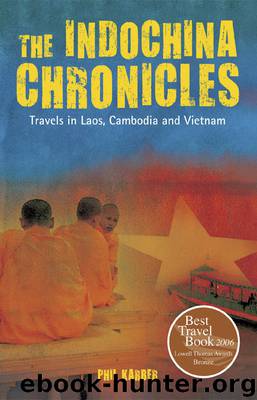The IndoChina Chronicles by Phil Karber

Author:Phil Karber
Language: eng
Format: epub
ISBN: 9789814435413
Publisher: Marshall Cavendish
After Bobby’s comical rehearsal, we grabbed three cyclos and set out for the north end of Nha Trang to the Po Nagar Cham Towers. En route, I had to endure my driver’s pitifully narrated saga of his parents having been killed during the war. He told his tale like Khmer Rouge survivors do, marking time before and after 1975. His acting job, however, was only slightly more convincing than Bobby’s was. Unfortunately this is a well-known con game used by the cyclo drivers of Nha Trang to garner extra tips, hogging the sympathy that real victims do indeed deserve.
We rolled up April 2nd Street, which commemorates the day in 1975 the communist army “liberated” Nha Trang, to the estuary of the Cai River. Serenaded by the exotic twang of loudspeakers blasting out plaintive love songs, knots of fishwives crowded the road, squatting around bamboo baskets and selling a variety of fresh clams and mussels. Past Xom Bong Bridge, up a tree-lined hillside, were the ocher-hued Cham Towers.
According to archaeologists, the site was first used for Hindu worship in the second century. The baked-brick towers were built between the eighth and 13th centuries to serve as the Holy See of the Champa Kingdom of Panduranga. In the 16th century, Nha Trang was the last Cham bastion of power to fall under the inexorable southward push of the Vietnamese.
The meditation hall, or mandapa, is an open space of octagonal, standalone columns. In ancient times, a pass through this ethereal space of brick columns was a spiritual warm-up before the main event of prayer in the Cham Towers. We ascended the steps up Cu Lao hill into the Hindu kingdom of heaven, which was crowned in statuesque palms, a sprawling banyan tree, feathery casuarinas and flowering acacia trees. The North Tower, the biggest of the remaining four towers, houses the shrine of Siva’s divine mate, Uma.
Cham creation myth has Uma emerging Noah-like out of a Great Flood, recreating the world and teaching her unskilled flock how to fish and farm. Once finished with that task, she morphed into a piece of sandalwood and drifted into the Eastern Sea before returning to heaven.
Facing eastward in sandstone relief above the doorway, Siva and Nandin hailed us. We made our way upstream against the current of a prayerful group of locals—travelers, fishermen and masses making offerings and praying for good fortune and safe passage on land and sea. Entering the main chamber, a smoky pyramidal vault festooned with ceremonial parasols, we burned incense on the altar, bowing three times to the bare-chested, ten-armed ebony statue of Uma.
Download
This site does not store any files on its server. We only index and link to content provided by other sites. Please contact the content providers to delete copyright contents if any and email us, we'll remove relevant links or contents immediately.
No Way Down by Graham Bowley(796)
Handy Pocket Guide to Tropical Plants by Elisabeth Chan(710)
Lonely Planet Thailand From the Source by Lonely Planet(661)
From the Source - Thailand: Thailand's Most Authentic Recipes From the People That Know Them Best (Lonely Planet) by Lonely Planet Food(629)
Handy Pocket Guide to Tropical Seashells by Pauline Fiene-Severns & Mike Severns & Ruth Dyerly(593)
Singapore Sling Shot by Andrew Grant(573)
25 Tropical Houses in the Philippines by Elizabeth Reyes(570)
Jakarta Undercover by Moammar Emak(549)
The Food of Northern Thailand by Austin Bush(537)
Lonely Planet Best of Malaysia & Singapore by Lonely Planet(503)
The Art of Japanese Architecture by Young David & Michiko Young(496)
The Rough Guide to Singapore (Travel Guide with Free eBook) by Rough Guides(491)
DK Eyewitness Top 10 Phuket by DK Eyewitness(482)
Handy Pocket Guide to Tropical Fruits by Hutton Wendy Cassio Alberto(478)
Singapore--Culture Smart! by Angela Milligan(442)
Thailand--Culture Smart! by Roger Jones(437)
The Rough Guide to Bangkok by Rough Guides(431)
The Second Poison by Pieter Wilhelm(429)
Ruined: A New Adult and Billionaire Romance (His For A Week Book 5) by Em Brown(410)
